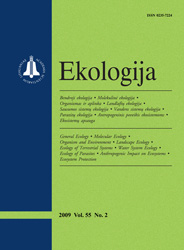Ekologija / Ecology
WHAT?
 ISSN 0235-7224 ISSN 2029-0586 (online) |
2011 m. Nr. 2 Habitat use and selectivity by beavers (Castor fiber) in anthropogenic landscape
The aim of this article was to reveal utilization peculiarities of various habitats by beavers in a relatively highly anthropogenic landscape of Lithuania. Particular attention was paid to habitat distribution and selectivity by beavers under conditions of dense population. At present, based on expert estimations, the total numbers of beaver population reach about 100 000 of individuals, with the average beaver site density of 0.41 site/km2. The greatest part of beaver sites (36%) was situated in canals of land reclamation in 2008. Beaver sites in natural rivers have comprised about 18%, in brooks – 12%, in lakes – 17%, in swamps and peat bogs – 15%. Habitat distribution of beaver sites was found to be related to landscape type. The most attractive habitats were the forest drainage canals (indicator of selectivity, HS = 3.5 ± 3.97 (SD)), followed by rivers (HS = 2.2 ± 1.78), lakes (HS = 1.2 ± 2.49). The least attractive habitats were the field drainage canals (HS = 0.3 ± 0.35). Utilization of habitats by beavers was found to be influenced by the structure of habitats. An increase of proportion of a habitat in the habitat structure, usually leads to an increase of the beaver site proportion in this habitat. This was found to be true for all habitat types, except the field canals due to a certain avoidance of this habitat by beavers. The increase of the proportion of a habitat in the habitat structure was found negatively influencing the usage of other habitats by beavers. In this respect, rivers, brooks, forest canals, and lakes were most antagonistic to the remaining habitats.
Keywords: Castor fiber, habitat distribution, habitat selectivity, anthropogenic landscape, Lithuania |
Issues:
2011 - Vol.57 No. 1, No. 2 2010 - Vol.56 No. 1-2, No. 3-4 2009 - Vol.55 No. 1, No. 2, No. 3-4 2008 - Vol.54 No. 1, No. 2, No. 3, No. 4 2007 - Vol.53 No. 1, No. 2, No. 2.priedas, No. 3, No. 4 2006 No. 1, No. 2, No. 3, No. 4 2005 No. 1, No. 2, No. 3, No. 4 2004 No. 1, No. 2, No. 3, No. 4 2003 No. 1, No. 2, No. 3, No. 4 2002 No. 1, No. 2, No. 3, No. 4 2001 No. 1, No. 2, No. 3, No. 4 |